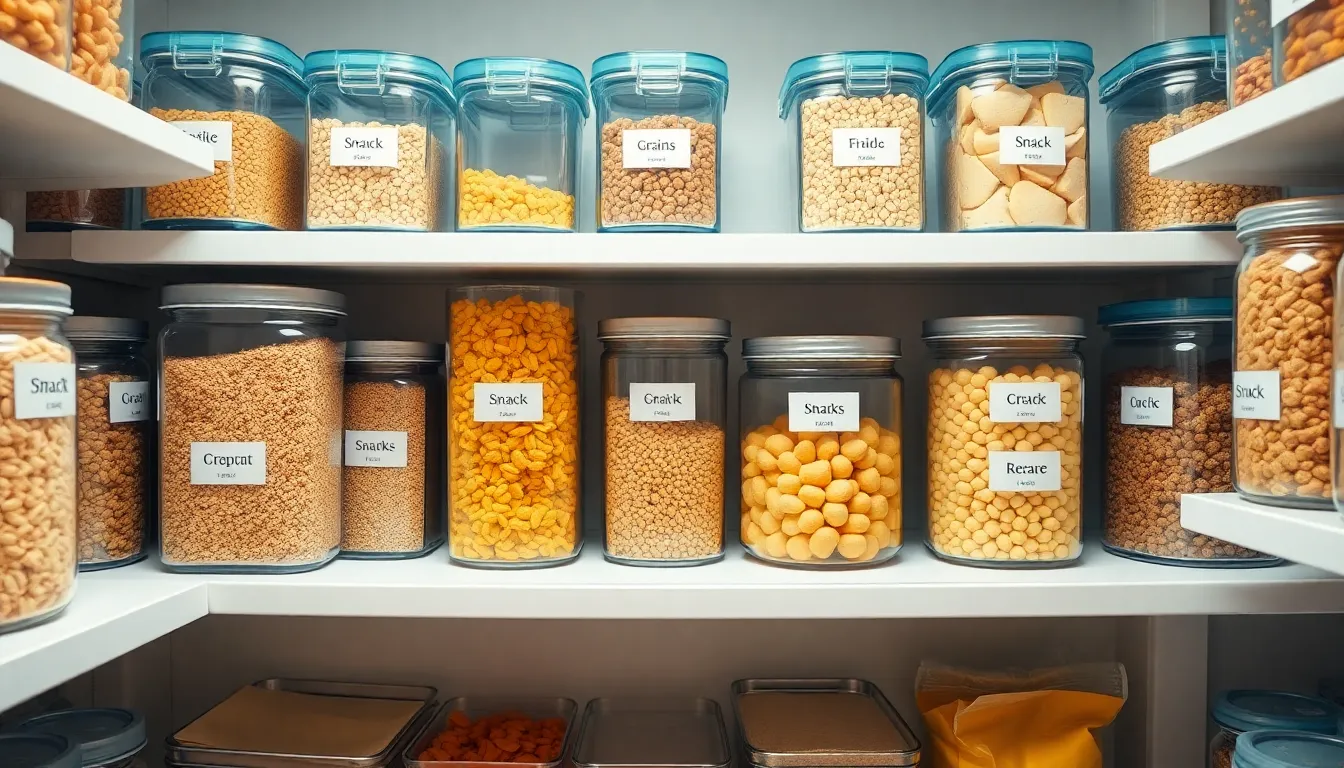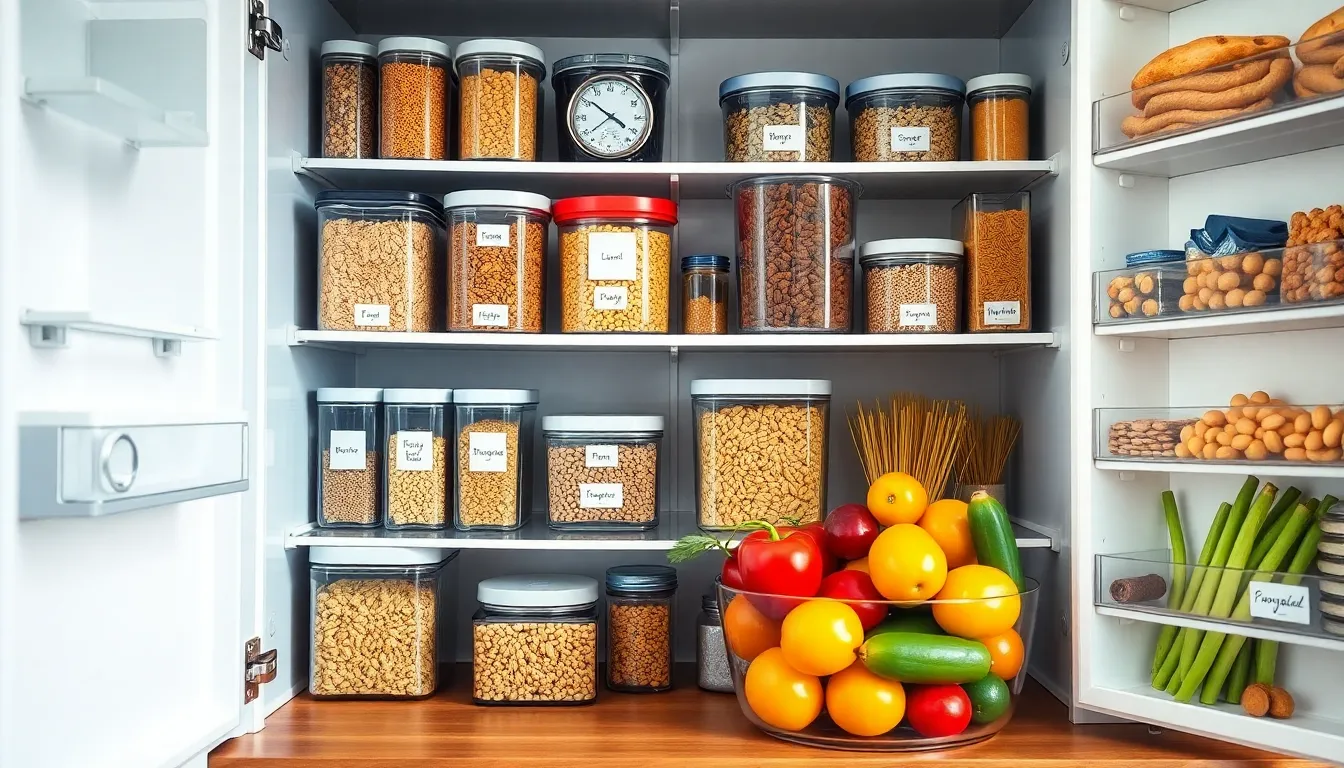Table of Contents
ToggleFood storage might not sound like the most thrilling topic, but let’s face it: nobody wants a science experiment growing in their fridge. With the right tips, he can turn his kitchen into a fortress of freshness, keeping leftovers safe and tasty.
Importance Of Food Storage Tips
Proper food storage significantly contributes to preventing spoilage and maintaining the quality of leftovers. Freshness directly impacts taste and safety, making effective storage crucial in every kitchen. Storing food incorrectly leads to waste and potential foodborne illnesses, which can be dangerous.
Using airtight containers helps minimize air exposure, extending the shelf life of various items. It’s vital to label and date containers, allowing users to track freshness and prioritize consumption. Furthermore, ideal temperature settings in refrigerators can inhibit bacterial growth, ensuring safety.
Organized storage not only keeps ingredients accessible but also reduces cooking time. Grouping similar items together and utilizing clear bins aids in identifying available ingredients quickly. Vacuum sealing offers an additional layer of protection from moisture and air, enhancing food preservation.
Leveraging the right storage techniques contributes to efficient meal planning and budgeting. Frozen foods, when stored correctly, can last several months without losing quality. Dividing larger portions into smaller packages promotes personalization and prevents overconsumption.
Awareness of proper storage methods enhances sustainability, reducing food waste and promoting environmental health. Adopting these tips impacts both personal health and the greater community, leading to healthier lifestyles and sustainable waste management.
Best Practices For Food Storage

Following best practices for food storage helps maintain freshness and safety. Implementing organized storage techniques can prevent spoilage and reduce waste.
Organizing Your Pantry
Creating an organized pantry simplifies meal preparation. Store items in clear, airtight containers to keep food fresh and make it easy to see what’s inside. Group similar products together such as grains, canned goods, and snacks. Use labels to identify contents and expiration dates. Placing frequently used ingredients at eye level enhances accessibility. Consider using a first-in, first-out system, ensuring older items are used first. Maintaining a clutter-free space supports efficient cooking and shopping habits.
Proper Temperature Settings
Setting the right temperatures is essential for food safety. Refrigerators should maintain a temperature below 40°F (4°C) to inhibit bacteria growth. Freeze items at 0°F (-18°C) for long-term storage. A thermometer helps monitor temperatures and prevents spoilage. Allow hot foods to cool before refrigeration to avoid raising internal temperatures in the fridge. It’s advisable to check temperatures regularly to ensure proper storage conditions. Keeping appliances clean and well-maintained enhances their efficiency and longevity.
Types Of Food Storage Containers
Selecting the right type of food storage container enhances food preservation and organization. Various materials and sealing methods cater to different storage needs.
Glass Vs. Plastic
Glass containers offer several advantages, including resistance to staining and odors. They withstand high temperatures, making them microwave-safe. In contrast, plastic containers tend to be lighter and more versatile. Many plastic options are designed for freezing, though some may warp under heat. Glass is often recommended for items with strong odors or acidic foods, while plastic provides convenience and portability. Both types benefit from staying airtight to maintain freshness, making proper sealing vital for optimal results.
Vacuum Sealing Options
Vacuum sealing provides an excellent method for prolonging food shelf life. Machines used for vacuum sealing remove air from bags or containers before sealing. Foods can remain fresh for weeks or even months compared to traditional storage methods. Various vacuum sealing options exist, including handheld devices and countertop machines. These options work well for both dry and wet foods, preserving taste and texture. For meal prep, vacuum sealing can streamline portions, allowing for efficient cooking and storage at home.
Common Mistakes To Avoid
Using the wrong type of container can lead to spoilage. Opt for airtight glass or BPA-free plastic to keep food fresh.
Ignoring expiration dates is another common mistake. Frequently check your pantry and refrigerator for dated items to promote proper food safety.
Overloading the refrigerator reduces air circulation. Maintain space between items to allow cold air to circulate efficiently throughout the unit.
Storing hot foods directly in the fridge poses risks. Allow dishes to cool to room temperature before refrigerating to prevent raising the internal temperature of the fridge.
Neglecting to wrap food properly leads to freezer burn. Use vacuum-sealed bags or heavy-duty foil for optimal protection against air exposure.
Not labeling containers can create confusion. Clearly label and date items to streamline meal prep and avoid inadvertently using spoiled food.
Failing to utilize the first-in, first-out method contributes to waste. Rearranging items regularly ensures older products get used first, minimizing spoilage.
Keeping the refrigerator above 40°F (4°C) encourages bacterial growth. Regularly monitor temperatures to maintain a safe environment for perishable goods.
Ignoring pantry organization can make cooking difficult. Group similar items together and keep commonly used products at eye level for easy access during meal preparation.
Underestimating the impact of moisture can ruin dry goods. Store grains and cereals in airtight containers to protect them from humidity.
Awareness of these common mistakes enhances food storage practices. Implementing these strategies ensures that food remains safe, fresh, and enjoyable.
Implementing effective food storage practices is essential for maintaining freshness and safety in the kitchen. By utilizing airtight containers and organizing the pantry, individuals can streamline meal prep while minimizing waste. Regularly checking temperatures and adhering to a first-in, first-out system are simple yet powerful strategies to enhance food safety.
Avoiding common mistakes like overloading the refrigerator or neglecting expiration dates can significantly improve food longevity. Embracing these tips not only fosters healthier eating habits but also contributes to sustainability. With a little effort and attention to detail, anyone can transform their food storage approach and enjoy the benefits of a well-organized kitchen.








